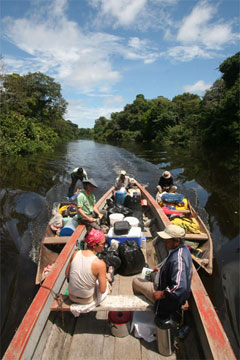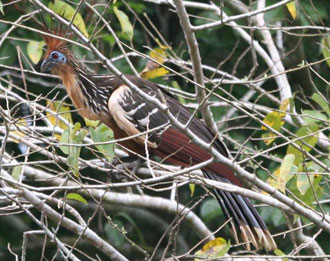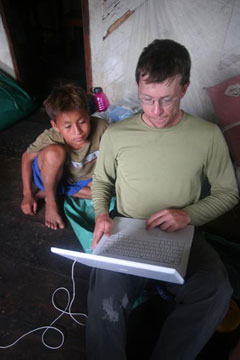Special to mongabay.com: Wilderness Classroom: Expedition 2006 The following is an update from The Wilderness Classroom’s expedition to the Peruvian rainforest. You can follow their adventures at wildernessclassroom.com |
Flooded forest habitat in the Amazon rainforest
The Wilderness Classroom Organization
May 2, 2006
Update 16: The flooded forest provides the perfect habitat for thousands of plants and animals – Dave
We are near the end of our journey through the Pacaya Samiria National Reserve, and we have experienced so many new sights and sounds that it is hard to recount all of them in our updates. Each week we’ve focused on a different topic to pass on the information that we are gathering for you. This week we will focus on habitat.
A habitat is an area where certain organisms (plant and animal species) naturally live and grow. Like your home, habitats support life by providing the food, water, and shelter that is needed to survive.
Throughout our journey we have had to work hard to shelter ourselves from rainstorms, stinging insects, and the blazing sun. We have faithfully purified our water in order to make it safe for us to drink. Fruit from the trees, and fish from the river have added to the rice, beans, eggs, oatmeal, and other food we bought in Iquitos.
We have utilized equipment and skills that we brought with us from the United States. We also rely on our knowledge and resources that we have acquired during our journey. Our survival has not been overly hard, but I am constantly amazed by how the people who live here permanently can not only survive, but thrive in the flooded forest.
The people that we have encountered do not rely on Gore Tex jackets, GPS units, gas stoves, water purification tablets, large bags of groceries, or modern first aid supplies to provide them with the food, water, and shelter that they need to survive. Instead they grow and gather their own food, drink water straight from the river, and build sturdy, elegant shelters using simple tools and materials they gather from the forest. They rely on their knowledge of the plants and animals of the forest; something that we are only beginning to understand.
 We were going to be late for our Chat on Friday afternoon. Luckily some rangers came by in a motorboat and towed us to the next ranger station, so that we would not be late for the chat. |
The knowledge the people in flooded forest have is irreplaceable. I believe using their knowledge of the forest, and working with them to develop ways to protect their habitat will protect the Amazon and other rainforests throughout the world.
Approximately 50% of the Earth’s plants and animals reside in tropical rainforests. It is imperative that we learn as much as we can about the world’s most biodiverse habitat. We also must work to ensure that the plants, animals, and people living in this amazing environment will continue to thrive in the Amazon rainforest for many generations to come.
We have only scratched the surface during our brief time in the rainforest, and I hope you will continue to join us for many more adventures in the Amazon Rainforest.
Student Explorers had a very tough Daily Dilemma to respond to on Friday. Fishing for endangered species poses a serious threat to fish populations. However, fishing is one of the only ways families can eat and make a living in the forest. Lots of students had great ideas including educating the locals about the role fish play in the ecosystem. Creating stricter limits for catching fish, and creating other jobs for locals were some of the great ideas sent to us from students.
Please join us in our chatroom on Wednesday, May 3rd from 8:30 AM to 9:30 AM CST, and on Friday May 5th from 1 PM to 2:30 PM CST.
 The hoatzin does not have predators, but it screeches a warning as we get close. |
Hoatzin – the Great Leaf Hunter – Patrick
Along the river we have been seeing a funny-looking bird that looks like a cross between a chicken and a pterodactyl- the flying dinosaur. Known as the hoatzin, these birds are rather clumsy flyers that respond to our approach by clambering through tree branches and announce their feelings with hisses and croaks. As we get closer, we see their great color combination- brown, orange and white feathers, red eyes, and bright blue facial skin.
Baby hoatzins are commonly preyed upon. A family or flock of 5-10 hoatzins typically stays near water so the little ones can dive into the water to escape predators. Until they can fly, hoatzin chicks get around using not only their feet but also a bizarre pair of claws near the end of each wing!
With their tiny blue head, clawed wings and awkward flight, we see why people once thought the hoatzin was a distant relative of the earliest known bird, the archaeopteryx, which arose during the late Jurassic Period almost 200 million years ago.
Hoatzins are herbivores. They eat only leaves and have a digestive system similar to a cow’s. Since leaves are hard to digest, hoatzins have adapted a three-part stomach; one of which uses bacteria in a process called fermentation. This process produces lots of gas, so hoatzins are said to be very stinky birds. Luckily we haven’t gotten a whiff of their smelly gas.
Hoatzins are large birds. It is logical to think that they would have lots of predators, but they are not tasty for eating. The leaves of one of the plants that hoatzins eat contain a toxic chemical. When eaten, the leaf’s chemical is absorbed by the hoatzin’s tolerant muscles. Even a starving person would likely turn down a stinky serving of hoatzin.
 Our nine year old friend, Luceo, couldn’t get enough of our technology. He had never seen a computer before. |
United States vs Peru:: I love them both! – Anna
From the people to the plants to the animals, the Peruvian rainforest is quite different from Chicago, Illinois. What a diverse world in which we live!
The people of the rainforest live a life so different than ours, that sometimes I feel like I’ve gone back in time. In Peru, life is simple. Life is free from the clutters (or luxuries?) of televisions, cars, fast food, shopping malls, and the Internet. Using materials from the rainforest, people build their houses with their own two hands. They eat preservative-free food straight from their gardens, the rivers, and the rainforest. They live among monkeys, pink dolphins, and macaws. Does that sound like a life you want to live?
But wait …a simple life does not necessarily mean an easy life. Would you be willing to give up the benefits of living in the United States? What’s the trade off?
The villages that we have visited do not have libraries. Their schools have no books, and they don’t have a hospital down the road in case somebody gets sick. People don’t live as long as they do in the United States and more babies die at birth. There is no air conditioning in the communities; in fact, there is rarely electricity.
The other day I was talking to a nine year-old boy about where he lives. When I pulled out a map of Peru, he stared at it with a blank look on his face. When I showed him a map of South America, he didn’t understand what we were looking at. The boy had never seen a world map.
That is a difficult thing for most of us to understand, coming from the United States. For this boy, however, it might be hard for him to understand why I can’t catch a fish with a spear, why I can’t find my way through the flooded forest, why I drive thirty minutes to work, and why I don’t know how to build a shelter from trees and vines.
No matter where you live, there is a trade off. No way of life is better than any other. There is no perfect place, free from difficulty. But one thing is for sure: no matter where you go, whether it be the Peruvian rainforest or Chicago, your life is what you make of it. I have found that in Peru there is beautiful scenery and kind people everywhere — just like where I come from in the United States.
Daily Dilemma #16: Is the malaria medicine really necessary?
To prevent malaria, we are taking a medication called Larium. But do we need to take the medication if there are little or no cases of malaria in the entire region where we are traveling?
Travelers going to tropical areas are always advised to take malaria medication. Malaria is a disease that is carried by mosquitoes. A person contracts malaria if they are bitten by a mosquito that bit a person with malaria.
According to the Director of the Pacaya Samiria National Reserve, there are so few cases of malaria in this region, that taking medicine is not necessary.
If the malaria medicine were giving me no side effects, I would have no problem taking it. Unfortunately, that is not the case. The medicine directly affects the nervous system, and in my case, is causing nightmares and lots of anxiety. I wake up with an anxious feeling in my stomach, and sometimes I go to bed with the same feeling. My body and mind feel a strange and unfamiliar nervousness most of the time. Additionally, the medicine affects my skin, causing a rash on my face.
Is it worth it? I want to fully enjoy my experience in the rainforest. If malaria isn’t even in this area, should I really be putting myself through the discomfort of the medicine?
Track the adventurers at wildernessclassroom.com